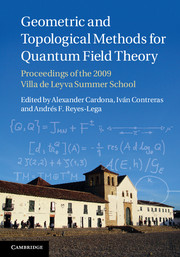 Geometric and Topological Methods for Quantum Field Theory
Geometric and Topological Methods for Quantum Field Theory Book contents
- Frontmatter
- Contents
- List of contributors
- Introduction
- 1 A brief introduction to Dirac manifolds
- 2 Differential geometry of holomorphic vector bundles on a curve
- 3 Paths towards an extension of Chern–Weil calculus to a class of infinite dimensional vector bundles
- 4 Introduction to Feynman integrals
- 5 Iterated integrals in quantum field theory
- 6 Geometric issues in quantum field theory and string theory
- 7 Geometric aspects of the Standard Model and the mysteries of matter
- 8 Absence of singular continuous spectrum for some geometric Laplacians
- 9 Models for formal groupoids
- 10 Elliptic PDEs and smoothness of weakly Einstein metrics of Hölder regularity
- 11 Regularized traces and the index formula for manifolds with boundary
- Index
- References
11 - Regularized traces and the index formula for manifolds with boundary
Published online by Cambridge University Press: 05 May 2013
- Frontmatter
- Contents
- List of contributors
- Introduction
- 1 A brief introduction to Dirac manifolds
- 2 Differential geometry of holomorphic vector bundles on a curve
- 3 Paths towards an extension of Chern–Weil calculus to a class of infinite dimensional vector bundles
- 4 Introduction to Feynman integrals
- 5 Iterated integrals in quantum field theory
- 6 Geometric issues in quantum field theory and string theory
- 7 Geometric aspects of the Standard Model and the mysteries of matter
- 8 Absence of singular continuous spectrum for some geometric Laplacians
- 9 Models for formal groupoids
- 10 Elliptic PDEs and smoothness of weakly Einstein metrics of Hölder regularity
- 11 Regularized traces and the index formula for manifolds with boundary
- Index
- References
Summary
Abstract
Let D be a first order differential operator acting on the space of section of a finite rank vector bundle over a smooth manifold M with boundary X. In this chapter we show that the index of D, associated to Atiyah–Patodi–Singer type boundary conditions, can be expressed as aweighted (super-)trace of the identity operator, generalizing the corresponding result in the case of closed manifolds obtained in [19]. We also show that the reduced eta-invariant can be expressed as a weighted (super-)trace of an identity operator so that, actually, the index of D can be expressed as a sum of two weighted super-traces of identity operators, one giving rise to the integral term in the Atiyah–Patodi–Singer theorem and the other one corresponding to the η-term.
Introduction
Let D be a positive order differential operator acting on the space of section of a finite rank vector bundle E → M over a smooth manifold M. When the manifold is closed, it is a well-known result that the index of such an operator can be written as a weighted (super-)trace of the identity, i.e. as a regularization of the trace of the identity with respect to some positive differential operator, usually of Laplacian type (see e.g. [19], [20]). These weighted traces (or pseudo-traces) are neither independent of the reference operator used to define them, nor traces on the algebra of classical pseudo-differential operators, but the obstructions associated to these anomalies can be computed explicitly in terms of Wodzicki residues, giving rise to local terms, i.e. terms given by integrals of smooth densities on the manifold M.
- Type
- Chapter
- Information
- Geometric and Topological Methods for Quantum Field TheoryProceedings of the 2009 Villa de Leyva Summer School, pp. 366 - 380Publisher: Cambridge University PressPrint publication year: 2013


